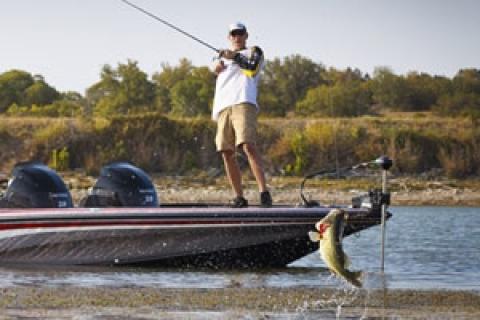

White mist swirled over the emerald green waters of Virginia's Leesville Lake, we raced toward the frothing commotion of churning gamefish and frantically skipping shad. Cutting the outboard motor, we cast our white bucktail jigs toward the melee and soon all three rods in the boat were bent double.
My lure pulled free, but was immediately grabbed by another hungry striper. Meanwhile, both other anglers in the boat, guide Dale Wilson and client Ralph Key, battled huge fish of their own. By the time the commotion ended 20 minutes later we had two mid-20s stripers in the boat, several smaller ones and a couple of chunky white bass.
That experience is a prime example of what makes jump fishing such an exciting angling method.
Species for Jump Fishing
While many people usually associate this tactic with bass or stripers, the fact is it can work for many different species, including largemouths, smallmouths, spotted bass, striped bass, hybrids, white bass, trout and many saltwater species. Sometimes you may just see a few fish slashing into baitfish on top, other times there'll be hundreds. Action may last three minutes or half an hour. In either case, it's tremendously exciting, sight-fishing for these topwater feeders.
When You Should Try It
While surface-feeding frenzies can occur during any season, summer through fall is one of the best periods. Early morning and late afternoon are best, but on rainy, drizzly days surface action can come anytime.
Where You Should Try It
 |
| Look for churned up water for gamefish crashing to the surface for food. |
Small lakes can yield good jump fishing, but the most consistent sport occurs on larger lakes with good shad populations. Start your search by asking marina and tackle shop operators where fish have been breaking lately. Often the water around the dam is a good bet in summer while feeder arms and their mouths may pay off better in fall.
Now Start Jump Fishing
Search for surface area that doesn't look the same. Look for white spray, water that looks ruffly or churned up. Scan for swooping gulls, jumping shad and gamefish crashing into them. Using binoculars can sometimes help you locate surface commotion from far away.
Then race to the commotion and arch casts in as quickly as you can.
Fish rarely stay on top feeding for long. Oxygen levels are low there and they may feel vulnerable to avian predators. Get to the commotion quickly. But always stay a short distance away and either drift or use your trolling motor to ease up the final few yards so you don't spook the quarry.
Lure Options
The ideal offering for jump fishing casts easily, rarely tangles its hooks and works well at a shallow-to-moderate depths with a medium-to-fast retrieve. The good thing is that the same lures will work for all species. Simply adjust the size to correspond to the bait the fish are feeding on and the size of the quarry.
 |
| Use a trolling motor to drift in on gamefish at the surface so not to spook them. |
Lipless crankbaits. These are excellent because they closely resemble a shad and sink fast — about a foot per second. Fish them right under the surface or up to 10-15 feet down. That's often where the larger fish in the school are lurking, nabbing bits of mutilated baitfish that drift down to them while the smaller fish tear into the school on top. Use 1/4 to 1 ounce versions in silver/black or chrome/blue. Cast out, countdown and then begin a steady retrieve.
Blade lures. These can be cast long distances, allowing you to stay far away and not spook the quarry. Use 1/2 to 3/4 ounce models in silver, chartreuse or gold. Retrieve in short pumps.
Tail spinners. Heavy and compact, tail spinners cast like a sinker and get down to the fish quickly. Cast to the middle or far side of the surfacing fish and let the lure sink on a tight line. Strikes will come on the drop.
Topwater chugger or popper. Work chuggers with a skittering, twitching or walk-the-dog motion. The one disadvantage to all of these lures is their treble hooks, which take up lots of precious time to remove. Try the next two lures to avoid that problem.
Soft-plastic jerkbaits. These single-hook artificials work twitched across the surface or pumped erratically just below it.
Bucktail jig. Plain and simple, but deadly. Fish it by itself in clear water or with a twister tail if fish are feeding on large forage or the water is murky. Use weights from 1/4 to 1/2 ounce and reel back smoothly with occasional pauses to let it sink down like a wounded shad.
Slab spoon. Once the commotion on top dies, fish are usually still slurping up bits of shad below. Drop a 1/2 to 1 ounce slab spoon like a Hopkins down and vertically jig until you see the next school of fish crashing bait on the surface. Then reel up quickly, crank up the outboard and get after them!
- 8752 views

